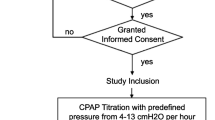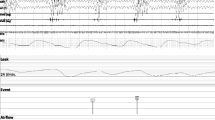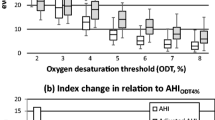Abstract
Purpose
Continuous positive airway pressure (CPAP) devices can estimate apnea-hypopnea index (AHI) using respiratory event detection algorithms. In 2012, rules for manually scoring respiratory events during sleep were updated to version 2.0. The purpose of the present study was to compare residual AHI determined using the Sleepstyle HC608 CPAP device (HC) with those determined by the new manual scoring (NM) rules during CPAP titration in patients with obstructive sleep apnea (OSA).
Methods
Fifty-seven patients underwent CPAP titration with HC. Correlations were assessed between AHI determined by NM and HC. The AHI, the apnea index (AI), and the hypopnea index (HI) were evaluated separately.
Results
The mean AHI as assessed using diagnostic polysomnography (PSG) was 53.9 ± 22.4. During CPAP titration, respiratory events were effectively suppressed (HC-AHI, 4.2 ± 6.0; NM-AHI, 6.0 ± 5.8). Lower HI and AHI were obtained using HC compared to NM (HC-HI, 2.9 ± 3.6 and NM-HI, 5.2 ± 4.2, p < 0.001; HC-AHI, 4.2 ± 6.0 and NM-AHI, 6.0 ± 5.8, p < 0.001). Additionally, HC reported higher AI compared to NM (HC-AI, 1.3 ± 2.8; NM-AI, 0.9 ± 2.2, p = 0.002). NM-AI (ß = 1.017, p < 0.001), NM-HI (ß = −0.599, p < 0.001), and NM-arousal index (ß = −0.058, p = 0.042) were associated with greater differences between HC-AHI and NM-AHI in multivariate regression analysis.
Conclusions
Our findings indicate differences in scoring respiratory events between our CPAP device and new version 2.0 manual scoring and suggest that residual AHI values should be carefully interpreted.




Similar content being viewed by others
References
Kushida CA, Littner MR, Hirshkowitz M, Morgenthaler TI, Alessi CA, Bailey D et al (2006) Practice parameters for the use of continuous and bilevel positive airway pressure devices to treat adult patients with sleep-related breathing disorders. Sleep 29(3):375–380
Leung RS, Bradley TD (2001) Sleep apnea and cardiovascular disease. Am J Respir Crit Care Med 164(12):2147–2165. doi:10.1164/ajrccm.164.12.2107045
Shahar E, Whitney CW, Redline S, Lee ET, Newman AB, Nieto FJ, O'Connor GT, Boland LL, Schwartz JE, Samet JM (2001) Sleep-disordered breathing and cardiovascular disease: cross-sectional results of the Sleep Heart Health Study. Am J Respir Crit Care Med 163(1):19–25. doi:10.1164/ajrccm.163.1.2001008
Nieto FJ, Young TB, Lind BK, Shahar E, Samet JM, Redline S et al (2000) Association of sleep-disordered breathing, sleep apnea, and hypertension in a large community-based study. Sleep Heart Health Study. JAMA 283(14):1829–1836
Peppard PE, Young T, Palta M, Skatrud J (2000) Prospective study of the association between sleep-disordered breathing and hypertension. N Engl J Med 342(19):1378–1384. doi:10.1056/NEJM200005113421901
Kushida CA, Chediak A, Berry RB, Brown LK, Gozal D, Iber C, Parthasarathy S, Quan SF, Rowley JA (2008) Clinical guidelines for the manual titration of positive airway pressure in patients with obstructive sleep apnea. JCSM 4(2):157–171
Morgenthaler TI, Aurora RN, Brown T, Zak R, Alessi C, Boehlecke B et al (2008) Practice parameters for the use of autotitrating continuous positive airway pressure devices for titrating pressures and treating adult patients with obstructive sleep apnea syndrome: an update for 2007. Sleep 31(1):141–147
Bradley PA, Mortimore IL, Douglas NJ (1995) Comparison of polysomnography with ResCare Autoset in the diagnosis of the sleep apnoea/hypopnoea syndrome. Thorax 50(11):1201–1203
Gugger M (1997) Comparison of ResMed AutoSet (version 3.03) with polysomnography in the diagnosis of the sleep apnoea/hypopnoea syndrome. Eur Respir J 10(3):587–591
Ueno K, Kasai T, Brewer G, Takaya H, Maeno K, Kasagi S et al (2010) Evaluation of the apnea-hypopnea index determined by the S8 auto-CPAP, a continuous positive airway pressure device, in patients with obstructive sleep apnea-hypopnea syndrome. JCSM 6(2):146–151
Ikeda Y, Kasai T, Kawana F, Kasagi S, Takaya H, Ishiwata S, Narui K (2012) Comparison between the apnea-hypopnea indices determined by the REMstar Auto M series and those determined by standard in-laboratory polysomnography in patients with obstructive sleep apnea. Intern Med 51(20):2877–2885
Prasad B, Carley DW, Herdegen JJ (2010) Continuous positive airway pressure device-based automated detection of obstructive sleep apnea compared to standard laboratory polysomnography. Sleep Breath 14(2):101–107. doi:10.1007/s11325-009-0285-z
Berry RB, Budhiraja R, Gottlieb DJ, Gozal D, Iber C, Kapur VK et al (2012) Rules for scoring respiratory events in sleep: update of the 2007, AASM Manual for the Scoring of Sleep and Associated Events. Deliberations of the Sleep Apnea Definitions Task Force of the American Academy of Sleep Medicine. JCSM 8(5):597–619. doi:10.5664/jcsm.2172
Iber C, Ancoli-Israel S, Chesson A, Quan SF. for the American Academy of Sleep Medicine (2007) The AASM manual for the scoring of sleep and associated events: rules, terminology and technical specifications. American Academy of Sleep Medicine, Westchester
do Park Y, Kim HJ, Kim CH, Kim YS, Choi JH, Hong SY et al (2015) Reliability and validity testing of automated scoring in obstructive sleep apnea diagnosis with the Embletta X100. Laryngoscope 125(2):493–497. doi:10.1002/lary.24878
Acknowledgments
This work was supported by the Soonchunhyang University Research Fund.
Conflict of interest
The authors declare that they have no competing interests.
Author information
Authors and Affiliations
Corresponding author
Rights and permissions
About this article
Cite this article
Kim, DE., Hwangbo, Y., Bae, J.H. et al. Accuracy of residual apnea-hypopnea index obtained using the continuous positive airway pressure device: application of new version 2.0 scoring rules for respiratory events during sleep. Sleep Breath 19, 1335–1341 (2015). https://doi.org/10.1007/s11325-015-1257-0
Received:
Revised:
Accepted:
Published:
Issue Date:
DOI: https://doi.org/10.1007/s11325-015-1257-0




